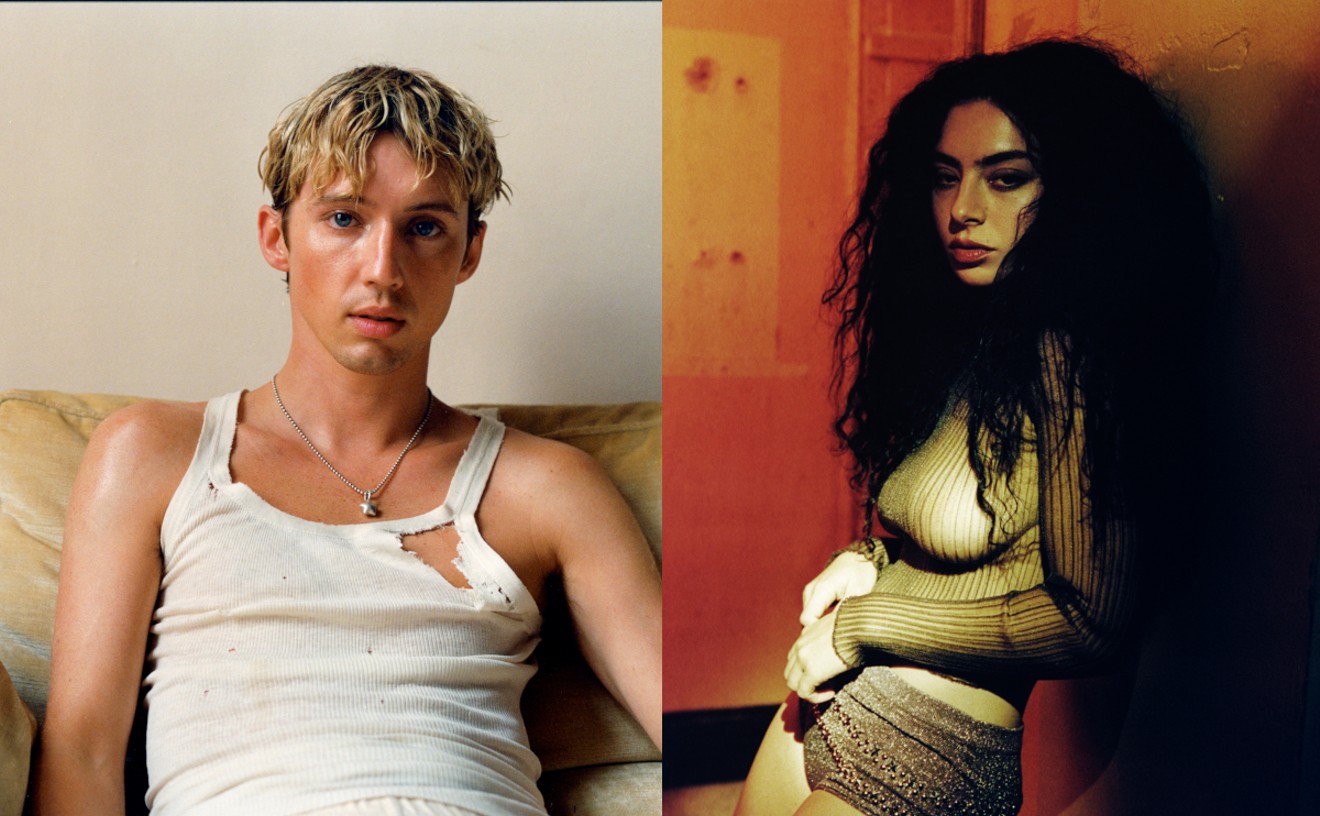Later, during a break, Albita sits on a director's chair in the studio's small, communal dressing room. She tugs at the flesh-colored corset beneath her diaphanous dress, adjusts her push-up bra, and sighs. "I like loose clothes," she grumbles in her usual bedroom voice. "I told them this dress was too tight, but they wanted me to wear it."
The outfit, like the South Beach-stylish video set, is consistent with the singer's updated image on the proposed bright red cover of the new CD, which features a sultry photograph of the songstress wearing a clinging dress and holding a wine glass. "It's all about glamour," Miriam Wong, Albita's long-time manager says enthusiastically. "This is an aggressive album. The last one was passive, and everybody walked right by it. It was too subtle."
On the black-and-white cover of that album -- No Se Parece a Nada, the singer's 1995 U.S. debut released on Crescent Moon -- Albita sported a mannish pinstripe suit and folksy beret. Heralded by the international press, the album sold more than a million copies worldwide and was on the Billboard Latin chart for fifteen weeks -- a respectable, but hardly remarkable number, in light of all of the disc's advance hype.
"Our sound is different," Albita shrugs. "Even though our music might be danceable and it might be catchy, it's hard to break through the established market categories." The singer seems eager to dismiss the album, which last year she described as "a true mix of Cuban music with Cuban music." An uneven recording that applied the electronic trademarks of Estefan's brassy, mass-market Miami Sound with a variety of Cuban styles, it did not succeed in capturing much of the soulful spirit that the group's local audiences and Albita herself had come to expect from the live performances.
Albita produced and arranged Dicen Que ... with her band's tres player, Julia Sierra. Their idea was to make it sound as much as possible like a live recording. "This time, everything is recorded directly by the musicians," she explains excitedly. "There are no synthesizers, no sampling. We recorded the basic tracks with the piano, percussion, bass, and tres together to give it the force of a live record. It really highlights the personality of the music."
The album's eleven tracks incorporate a variety of traditional Cuban music styles, principally son and rumba, together with elements of other Latin dance rhythms and Latin jazz. "El Son del Tahurete" is a traditional son, played on guitar, tres, piano, lute, bass, and percussion. "Son del Organo Oriental" has a countrified sound, with an emphasis on flute and organ solos; the band members echo Albita's vocals in African-style call-and-response chants.
"Hoy No Voy a Trabajar," a rowdy, carnival-esque anthem, relies heavily on Afro-Cuban percussion and solos from guest trumpeter Arturo Sandoval. "Traigo un Corazon Rumbero" offers a melange of son montuno, cha-cha-cha, rumba and other big-band styles, and Albita even indulges in some scatlike vocal improvisation.
For the most part, Dicen Que ... is a dance record, but Albita has also included two examples of guajira, the Cuban country music that Albita was credited with reviving single-handedly in Cuba before she defected to Miami in 1993. An upbeat version of an Albita classic, "Habra Musica Guajira" (also the title of her 1988 album recorded in Cuba), is a standout on this record -- a soulful lyric poem backed by a string ensemble of tres, lute, violin, viola, and cello, as well as subtle wind and percussion interludes. "Ay Mi Barrio" is another gorgeous ode to rural life.
Dicen Que ... has its share of instrumental highlights -- Fernando Pina's Afro-Cuban percussion, Mercedes Abal's flute playing, Viviana Pintado's piano, and notably, Julia Sierra on tres (her solos are never long enough). Although the musicians on this album are extremely accomplished, when their work is crammed into every track their virtuosity can sound like too much of a good thing. Most of the time, Dicen Que ... bombards the listener with sound. The album is hyper, lacking in nuance, and Albita's phrasing seems hurried. What suffers most is the singer's voice, which at times seems to be struggling to keep pace or almost shouting over the roar of the band. She has little room to stretch out and indulge her considerable range. The new album does convey the energy of the group's live show. But the arrangements can get so busy that at times it seems like Albita wants to squeeze the entire musical history of Cuba into one song.
The almost manic nature of the record might be a plus when it comes to appealing to a Latin radio market weaned on fast-paced merengue and salsa. "El Chico Chevere" is basically a son, but it has a full sound and an emphasis on horns that makes it salsafied. It's not surprising that Sony chose it for the first single.
"It's more danceable and it has more to do with what's playing on the radio internationally as far as Latin music goes, but I don't know if it's so commercial," the singer cautions in reference to the track. "It's a very Cuban sound. It's the sound that the bands in Cuba are playing now.
"I almost never talk about my albums because I'm almost never happy with them," continues Albita, who recorded two albums in Colombia before moving to Miami. "But I think this is the best one I've ever made. I'm very happy with it." She refuses to predict how Dicen Que ... might fare on the radio in South Florida and in other Latin markets.
"No, no, no," she says when asked about her past experience with radio airplay. "I don't know. With me the radio doesn't -- I think that there are artists who are born to play live," she blurts out. "The radio can get you access to a lot of things, but my success is largely due to my live presentations. I'm not afraid of that. I like it, I enjoy it. People like it and they enjoy it."
Albita has been playing on Friday and Saturday at Yuca on Lincoln Road since January, following her departure from a long-standing gig at Little Havana's Centro Vasco. At Yuca, wearing her mix-and-match outfits, telling bawdy jokes, and singing "twenty minutes of Cuban music ... then twenty minutes of Cuban music ... and to wrap it up twenty minutes of Cuban music" for the gazillionth time, she runs the show.
Her group has grown to eight musicians, from the four who arrived in Miami with her, and Albita is even more visibly out in front -- unmistakably the star. But the routine is much the same as always: The musicians dance in clogs; the female members sing a cappella; Albita encourages the audience to wave red napkins for the Afro-Cuban deity Chango. The crowd of well-heeled Cuban-American regulars -- the ones who know every word to every song -- is now mixed with younger, equally passionate fans, and more out-of-towners have come in since her picture appeared in the New York Times "Arts and Leisure" section last month in a story on Latin entertainment in Miami. Every night that she performs, without fail the restaurant's upstairs bar is packed with about 350 people.
"I think that my destiny is to perform live," Albita asserts, changing into a slinky black sheath for the next scene in the video. "For me, it's fundamental that people see me -- one, two, or three times."
Albita says that a tour supporting the album is in the works; she'll go to Europe, Latin America, and cities across the United States. The singer reports that, to her surprise, over the past year the group has packed New York's S.O.B.'s, Los Angeles's House of Blues, and had a successful appearance at the North Sea Jazz Festival in Holland. She attributes this reception to word of mouth, adding that people who have seen her show in Miami tell their relatives and friends back home.
"I've always been of the opinion that audiences are the same all over the world," Albita contends, heading out of the dressing room in bare feet onto the studio floor, where three male dancers in guayaberas are waiting to form a conga line behind her. "You just have to know how to tickle them in the right place."
Albita performs on Fridays and Saturdays at 10:30 at Yuca, 501 Lincoln Rd, Miami Beach; 532-9822.










